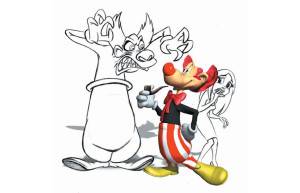
Chapter Summaries for the Book Thinking Animation: Bridging the Gap Between 2D and CG
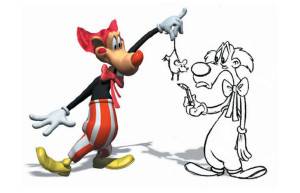 “I miss my pencil.” – Troy Saliba
“I miss my pencil.” – Troy Saliba
Animators find themselves in the midst of a momentous change in our industry. As in many other fields, the computer has made what is known as a disruptive impact on our art form. Think of the car and the horse, the cellular phone and the pay phone, the CG feature and the 2D feature[el]. The introduction of the computer has changed an art form that had been, up until now, a pen and paper medium for upwards of 80 years. Three major shifts are responsible for the progression from pencil to a mouse in feature animation. These shifts can be traced to changes in audience, technology, and storytelling.
“What makes for a good plot? A giant monster, a pretty girl and an obsessed scientist. Oh, and the scientist should smoke a pipe.”
– Chris Bailey
There are many books out there that talk specifically about how to write a good story. Here, we touch upon some the important facets of telling a great story for animation. We talk about storyboards and their importance to the development of a visual medium such as filmmaking. In this chapter we tell you about the evolution of the storyboard into animatics, layout, workbook, pre-visualization, and choreography, and how these tools have made the story artist’s job easier in some ways and a lot more complex in others. Each of these tools is used in animation to help refine the story and get to the heart of what the audience should be experiencing. The storyboard of traditional animation has evolved into a complex set of steps in CG to ensure that all the pieces of the puzzle fit.
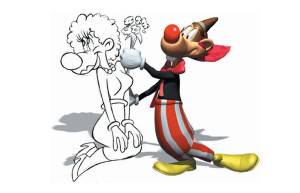 “Charlie Brown is my favourite because everybody hates him and he knows it.” – Darin McGowan
“Charlie Brown is my favourite because everybody hates him and he knows it.” – Darin McGowan
Memorable characters are a mix of traits we relate to and find appealing. A character must have some kind of appeal—both physical (good design) and emotional (strong personality type)—the audience identifies with and roots for. Even villains should have this kind of appeal. As much as the audience wants the hero to get what he is after, you are quietly rooting for an unbeaten villain to get his, too. A fully developed character stands out on the screen as acting human like. This chapter explores how to infuse your characters with personality, flaws, believable traits, motivation and further explains how to translate a 2-dimensional drawing into an appealing CG character.
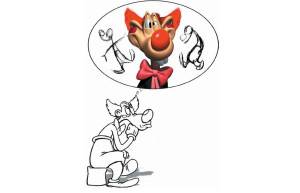 “To just jump in and start animating so the director sees something, anything is a waste of time. Think about what you want to do. Then think about it again.” – Brian Dowrick
“To just jump in and start animating so the director sees something, anything is a waste of time. Think about what you want to do. Then think about it again.” – Brian Dowrick
Excitement! This is what you feel when you have been handed a really juicy scene to animate! So you’re excited; what do you do? You turn on that computer and start animating. No! Idiot! Have you learned nothing? Don’t you dare! This will only lead to a scene that is convoluted and hard to follow at best. You must think about your scene and get inside the head of the character in the space and time of the story. Over the years, animators have adopted many approaches to how they think about their scenes. This chapter introduces and labels some of these techniques. b Using the practices in this chapter, you will create something that is original and unmistakably clear in performance.
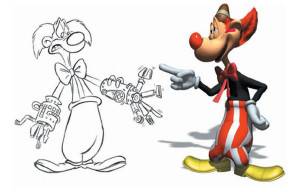 “Animating with a computer is like getting both hands cut off and trying to use robotic arms in one of those plastic containers to handle toxic stuff.” – Nik Ranieri
“Animating with a computer is like getting both hands cut off and trying to use robotic arms in one of those plastic containers to handle toxic stuff.” – Nik Ranieri
Whether you came from a stop-motion, 2D, or CG background, you’ve no doubt been frustrated by trying to animate with a computer at one time or another. The computer distances you from the final image. It has a remote nature that is not as tangible as 2D or stop-motion. There are a literally thousands of controls at your disposal when animating on a computer and you have to establish an efficient workflow to be successful. The tools can often be not only complicated, but sterile and mechanical, so you must develop a process that is more approachable, streamlined, and natural to you. Workflow, posing, breaking the rig, in-betweens, breakdowns, and many more tools are discussed here to help you push your CG animation to a higher level.
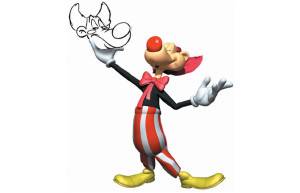 “If you and I are acting on stage, and I touch your cheek, you will have an emotional reaction of some kind. You and I will both deal with that reaction, which will lead us to the next moment. An animator must create the illusion of a present moment.” – Ed Hooks
“If you and I are acting on stage, and I touch your cheek, you will have an emotional reaction of some kind. You and I will both deal with that reaction, which will lead us to the next moment. An animator must create the illusion of a present moment.” – Ed Hooks
Acting is the heart of your animation performance. Each shot of every scene builds upon the performance and supports the intent of the story. The job of an animator involves re-motivating an acting moment in the movie again and again for weeks on end. Animators do not necessarily want to be actors (although some are real characters). To animate well, animators have to understand what an actor knows and how the actor prepares for a scene. The way an animator “acts” is very different from the way an actor “acts.” An animator has to be more analytical than an actor in his or her approach to a scene because the actor acts in the moment, and an animator has to be in the moment.
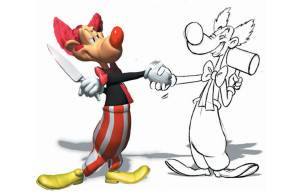 “You just have to play well with others.” – Cathlin Hildalgo-Polvani
“You just have to play well with others.” – Cathlin Hildalgo-Polvani
Studio politics. It’s everywhere you go, and we are your studio politics “tour guides.” We have experienced almost every situation in this chapter and have made many mistakes through frustration with the process of politics within the animation studio. In this chapter, we walk you through many possible sticky situations that could arise (and eventually will) and how to handle them with class and restraint.
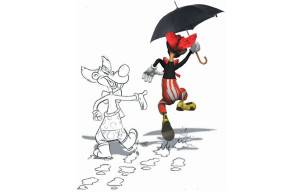 “Our studio has a tiny yard in the back and it was raining one day. I had only been an employee for a few weeks and took a break to watch the rain fall. As I stood there and watched, the company president walks up and stands next to me, casting his gaze to the rainfall. I had only met him briefly before and not ‘really’ spoken with him, and definitely not one-on-one. I thought to myself, “Wow, I wonder what words of wisdom he might bestow upon me at this moment. I wonder what my reply will be and if I’ll make a good impression?” The company president then says, “Sure is a lot of mud out there.” My reply was, “yeah”… – Roberto Smith
“Our studio has a tiny yard in the back and it was raining one day. I had only been an employee for a few weeks and took a break to watch the rain fall. As I stood there and watched, the company president walks up and stands next to me, casting his gaze to the rainfall. I had only met him briefly before and not ‘really’ spoken with him, and definitely not one-on-one. I thought to myself, “Wow, I wonder what words of wisdom he might bestow upon me at this moment. I wonder what my reply will be and if I’ll make a good impression?” The company president then says, “Sure is a lot of mud out there.” My reply was, “yeah”… – Roberto Smith
We are now armed with all the ammunition that history has provided us to march through on our way to something great! We are but fleas on the shoulders of giants in this industry. We have much to learn from our animation forefathers, such as John Whitney Sr. and Jr., Walt Disney and his Nine Old Men, Chuck Jones, Tex Avery, Bob Clampett, Robert Abel, Richard Taylor, and so many others. We have much to examine as this young field we call CG animation unfolds and reveals the new pioneers, such as John Lasseter, Chris Wedge, Brad Bird, and more to come. The only way to predict trends in an industry driven by art, commerce, and technology is to look at the past and learn.
TIMELINE
A timeline from 1800-2005 is placed at the footer of each page, so the reader can flip through and see events that happened both in traditional and CG animation throughout history.
AUTHORS BIOS
Over 50 working professionals contributed to this book and their complete bios are listed in the back of this book.
PRODUCTIONS FROM 1994-2005
A complete list of all 2D, Stop-Mo, CG and FX movies produced since 1994 and their domestic box office profits are compiled into an easy to read chart that shows the changes in the audience.
ANIMATION TRENDS
A breakdown of the history of American animation is broken into The Golden Age (1928-1941), The War Time Era (1942-1945), Post War (1946-1980), The Second Golden Age (1981-1995), and finally the Digital Age (1996-?). This historical account provides a thorough list of films all animators should have studied.
ANIMATION HALL OF FUNNY
Our favorite section, this appendix has some comics and quotes that came directly from days in production like “I am not sure what I want, but that is not it…”
PRINCIPLES OF ANIMATION
Developed by animators at Disney years ago, this is a quick summary of the principles of animation.
GLOSSARY
Character animation and CG animation terms are defined here.
FURTHER READING
This is a list of recommended reading in addition to our book.
BLOG
Javier Solsona was kind enough to keep a blog while he worked on the cartoony rig for Redd the Clown. Since there is no guarantee the blog will remain online, we decided to reprint it here in the back of the book, for posterity.

